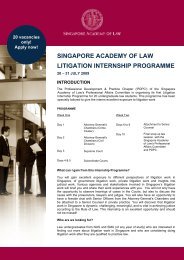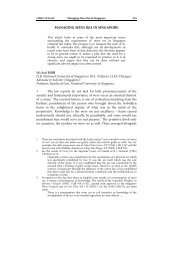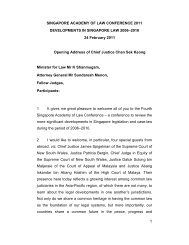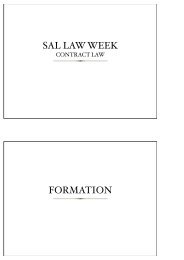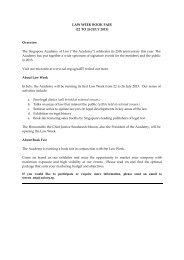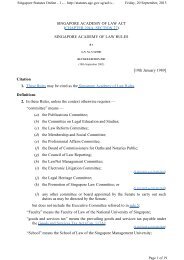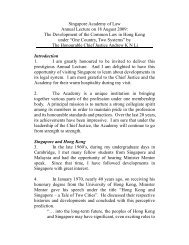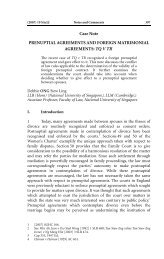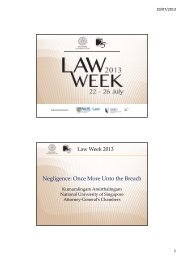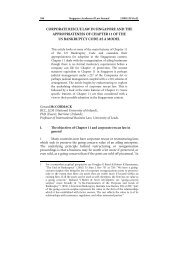View Article - Singapore Academy of Law
View Article - Singapore Academy of Law
View Article - Singapore Academy of Law
You also want an ePaper? Increase the reach of your titles
YUMPU automatically turns print PDFs into web optimized ePapers that Google loves.
290<br />
<strong>Singapore</strong> <strong>Academy</strong> <strong>of</strong> <strong>Law</strong> Journal (2003)<br />
evidence led in one action would be treated as having been led in all<br />
other actions…In such trials <strong>of</strong> several actions, which involve common<br />
issues <strong>of</strong> fact and the same questions <strong>of</strong> law, the preparation <strong>of</strong> the<br />
opening statements, list <strong>of</strong> issues, list <strong>of</strong> propositions <strong>of</strong> law and bundle<br />
<strong>of</strong> documents in accordance with the Practice Directions should again<br />
be approached on a combined basis wherever practicable and<br />
convenient. In such trials, a trial judge also encourages a common core<br />
bundle <strong>of</strong> documents for ease <strong>of</strong> reference and in the interest <strong>of</strong> a speedy<br />
trial.” (per Lai Kew Chai J, Lee Kuan Yew v Tang Liang Hong & Anor<br />
and other actions (3), at paragraph 5)<br />
194 In the light <strong>of</strong> the foregoing, it is submitted that the key to<br />
deciding whether the civil suit should be consolidated with the ancillary<br />
matters or merely ordered to be tried at the same as the ancillary matters<br />
is the number <strong>of</strong> parties (aside from the husband and wife) who are<br />
involved in the civil suit, the extent to which they have each obtained<br />
separate legal representation, and how far advanced the civil suit is—<br />
which would indicate how much work has been done thus far by the<br />
various parties’ lawyers, and the legal costs incurred.<br />
195 If there is no need for the civil suit and the ancillary matters to<br />
be consolidated or tried at the same time, the court may order the matters<br />
to be tried in immediate succession, usually before the same judge. This<br />
would usually be in a situation where: (i) the issues must be dealt with<br />
discretely—i.e. where the outcome in the first matter would affect the<br />
decision in the second matter in such a way that it would not be possible<br />
to hear the second matter without knowing the outcome in the first<br />
matter; or (ii) where the issues may be dealt with discretely, and factor<br />
(c) in Section 6.1 (i.e. common witnesses in both matters) above is<br />
present, but not factors (a), (b) and (d) (i.e. common issues <strong>of</strong> law and<br />
fact, and a close connection between the 3 rd party issue and the ancillary<br />
matters such that the court dealing with the civil suit must be appraised<br />
<strong>of</strong> the ancillary matters, and vice versa).<br />
196 When the matters are consolidated or tried at the same time, each<br />
witness giving evidence will give evidence <strong>of</strong>, and be cross-examined<br />
(where applicable) on all the issues raised in the civil suit as well as the<br />
ancillary matters proceedings. The affidavits <strong>of</strong> evidence in chief will be<br />
drafted to reflect this. One judgment will be written covering both<br />
matters. In the Shi Fang case, this is what took place (see Section 6.1<br />
above). Where the matters are tried in succession, then, strictly speaking,<br />
the witnesses called and the affidavits <strong>of</strong> evidence in chief filed in<br />
respect <strong>of</strong> the first matter should only be in relation to the issues arising<br />
in the first matter. A decision will then be made in respect <strong>of</strong> the first



